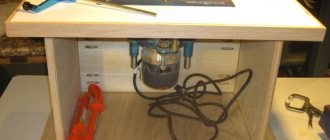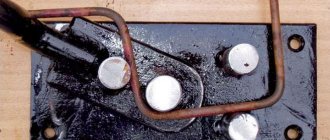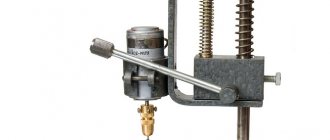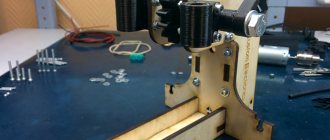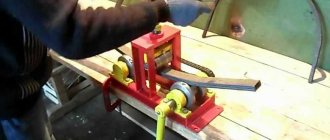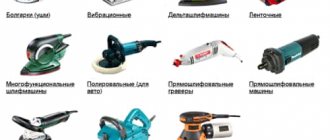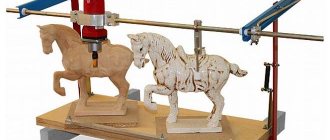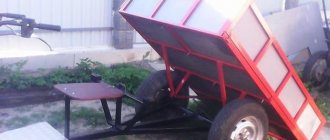Making a sheet bending machine with your own hands is not so difficult, but craftsmen, both amateur home-made workers and individual entrepreneurs who live by their labor, still use it little. Meanwhile, the price of only ready-made additional roofing elements - valleys, ridges, eaves strips - and drainpipes with gutters is several times higher than the cost of the material. The same applies to paintings (roofing sheets, completely ready for laying) with double-seam edging. And that's just roofing work.
Meanwhile, many craftsmen still prefer to either buy ready-made parts, losing money, or make do in the old fashioned way with a hammer, losing potential customers - modern products should not look like crap. What's wrong here: economics, technology, prejudices? Or maybe just ignorance? Maybe you just need a clear drawing of a sheet bending machine that you could build yourself in a shed, and use it for a long time and successfully? Let's try to figure it out.
Among the main indicators (efficiency, productivity, simplicity of design), it is also necessary to determine durability, subject to stable performance results. At the height of the season, when the day feeds the year, there is no time to bother with repairs or adjustments, and with occasional use once a month, not every month you can do without special equipment, see below.
The minimum requirements are for a jack-of-all-trades who does roofing and tin work on a case-by-case basis when there are orders; Buying an industrial machine like this is expensive and won’t pay off. But then a homemade sheet bender must withstand at least 1200-1500 working cycles per season without deteriorating the quality of bending. There is another important point - corrugated sheeting. More precisely, its independent production. It is worth special mention.
Types and their design
The main distinction between all machine equipment is based on the type of drive:
- Manual. It is driven by ordinary human power. These are primitive, but quite effective devices with minimal accuracy and no costs.
- Mechanical. It implies the presence of a lever with subsequent conversion of pressing force.
- Electromechanical – has an electric motor as a driving force. The use is especially relevant if there is a press at the factory, this is how mass production of parts is stamped.
Simple manual
The thinnest sheets can be evenly bent at any angle in the presence of metal (wooden) stops (clamps) and a traverse. This means that the lid, which covers the upper section, producing a bend, is applied solely by hand force without any additional amplifier. Let's look at the design of a homemade sheet bender in the diagram:
Powerful machine made of brands
This is a device with a pressure beam that can clamp and even cut steel. Usually the equipment has a protractor - this is a disk that allows you to set any pressure angle. A steel sheet is secured to the feed table and then advanced further if necessary. Pressing the handle causes the clamping tee to move, while the bending beam remains in place. Let's look at this sheet bender:
Rollers for steel
There is a device with three shafts, when the workpiece passes between them and bends. If you adjust them (remove and install with different diameters, place them at a larger or smaller distance), you can achieve a different bending radius. The result is not an acute angle, but a smooth wave. This is what it looks like:
Note to masters
Of course, it’s not easy to “recapture” $2000 for an individual master. Therefore, let’s try to figure out how to make a sheet bending machine yourself. Not for corrugated sheeting, but for a variety of roofing and tin work, on which you can also make a good living and raise some money to start something more serious. Non-standard little things fundamentally cannot be unified, but are always needed. And a homemade sheet bender can be a very good help here.
About purchased handbrake
To put an end to the “company” (the article is not an advertisement) and move on to homemade products, let’s briefly look at what you can buy if you still need it. The market is clearly dominated by TAPCO and VanMark. And the domestic SKS-2, produced in Orsk, is almost unknown. In terms of price, they are all about the same; The width of our working area is 2.5 m versus 3 m for foreigners, but this is not a defect. 3 m is designed for the inch system of measures (10 feet = 3.05 m), and in metric 2.5 m is just more convenient.
But the Uralian is a passing type; you can, for example, pull gutters up to 90x90 mm. The traverse is raised/lowered using eccentrics; there is no need to turn the flywheels. Supplied with a cutting knife. User reviews are not only favorable, but enthusiastic. The general tone is “an irreplaceable hard worker.”
History repeats itself. Nikita Khrushchev spoke about similar situations live on Central Television after his trip to America (when he was there hitting the UN podium with his shoe and threatening to make everyone’s motherfucker). They say that in the States they know how to sell any obscene rubbish, but here we cannot properly serve the necessary good things.
How to make a sheet metal bending machine with your own hands according to drawings from what is at hand
Manufacturing the structure can be extremely simple and cheap if you use spare parts from trash lying around in the garage. We may need:
- Any strong steel beams or part of a metal profile for the bed.
- A chain from a bicycle/motorcycle, if an electric drive is installed.
- Shafts from the car that will need to be turned.
Of course, to work with thin sheet metal, sometimes you don’t even need to make equipment; you can simply use the “old-fashioned” method, namely, take a mallet and, leaning the steel against a sharp and hard corner, beat it off.
What are car thresholds made of and what are they intended for?
Thresholds for vehicles are divided into several types. The difference between them is how they are attached to the vehicle and what exactly they are intended for.
Let us examine in detail what types of thresholds for cars there are.
- Fixed. Such thresholds are attached by welding and form an integral body structure. She looks tougher.
- Removable. Unlike non-removable ones, these thresholds are attached to the lower parts of the vehicle body using self-tapping screws or special bolts. They can be either protective or as an additional step.
- Power thresholds are installed on frame SUVs. They are attached to the frame by welding or using special powerful bolts and nuts. This power structure will be much larger than the thresholds on cars that have a monocoque body.
To understand the process, consider the types of sheet bending machines
There are not as many of them as it seems.
Roller
Additionally, it is called three-roll. As a result of metalworking, smooth curves are obtained on the surface. In this way, pipes and half-cylinders can be created that can be adapted for catch basins, street storm drains and much more. Metal rolling is carried out between rollers that have different radii. One shaft sets everything in motion, while the other two remain supporting.
Press brake
There is a template. It is created from strong metal and is double - that is, a matrix and a punch, which have mirror-opposite curves that complement each other. A blank is placed between the two forms. The lower part is motionless, and the second moves up and down, and when pressed, it lowers with great speed and pressing force. The sheet bends.
Homemade sheet bending machine: mechanism made of traverses
If in the press there is a point impact, then here it is across the entire width of the area. The element is fixed in the clamp, and its edge is bent under the influence of a movable traverse. The advantage is that you can produce parts with any angle - from 0 to 180 degrees. Often the device is equipped with a built-in knife and makes the bed multifunctional.
Roller
The second name is end manual. Designed for processing ends and small areas of sheet metal. Only physical strength is used, so it is not very common and is considered additional.
Safety precautions
Standard safety precautions require mandatory compliance with the instructions for servicing manual sheet bending machines:
- setting the required bend angles on the limiter;
- control of established data using a protractor;
- checking the correct installation of the working tool;
- neat placement of the bending element on the frame part of the device;
- performing test bending and, if necessary, making adjustments;
- recheck the correct bending.
It is important to monitor the correct progress of all bending operations, as well as timely check the technical condition of the device, keep the sheet bender clean and tidy
How to make a bending machine with your own hands
You need a steel corner, it needs to be cut into pieces of 1 meter. We take the ball joint holder and cut out holes for the hinges for the movable traverse. Next you need to make a support for opening. Next, we make the second, moving part in a similar way. It is necessary to reproduce it so that there is a minimum gap between the ends and complete accuracy. Pay special attention to the edge - it must be perfectly smooth, since the steel will bend at this point. Next, we screw the handle onto the rotary angle - the mechanism itself is ready. Then you need to install it on a stationary and reliable frame.
Additional accessories
To make the design more convenient, you can use wing bolts instead of regular bolts. They will add “springiness”. You can also use a roller knife and cut along the upper pressure crossbar.
Temporary apparatus according to a simplified scheme
If the above option is stationary, then this one is for temporary work. You can take three corners, fasten two of them together with a regular door hinge, and the third, using a clamp, should be pressed against the workbench, thus ensuring static stability.
How and why to make a sheet metal bending machine with your own hands
Many craftsmen need such a unit. It can be purchased, but the purchased models are characterized by large dimensions, weight, and also high prices. At home, it is not necessary to use electrically driven devices; a manual design is sufficient - it is easy to use, apply and create, and is also quite effective. If you are working with aluminum or thin steel, you can use wooden parts rather than steel parts for the equipment, and make the punches and angles themselves from metal for strength.
Pressure bar
Now let's move on to the design of the clamping bar (pictured above). It is also made from a corner, but is laid on the machine with an upward bend. To ensure that the bar does not bend during operation, reinforcement is welded on - metal jumpers. Small metal platforms are welded at both ends of the strip, in which holes are drilled for bolts.
Another important point is that the edge that faces the bend is cut off to obtain a sharper bend angle.
Listogib: is it difficult to do it yourself?
Most craftsmen claim that preparation and implementation generally takes less than a day, despite the fact that the materials need to be processed, because elements that are often rusty and not quite suitable for the parameters are taken. Next, we present the varieties depending on the ease of assembly.
Types for home use
- Rotary (clamping, with traverses) - quite simple, but take up significant space. They can be prepared from scrap materials. They are most effective when combined with cutting knives.
- Rotary (with rollers) - they are much more complicated, since the elements themselves require preliminary metal processing on turning equipment, and an electric drive is an additional complexity.
Qui prodest?
Translated from Latin - who benefits? Producing corrugated sheets yourself, at least for yourself, is a very popular material. Let's try to figure it out.
A manual pass-through type sheet bender (see below) costs about $2000. It seems that in a day or two a ton of 0.55 galvanization worth $1000 can be converted into 250 square meters. m of corrugated sheets, which would cost $1,400 to purchase. It would seem a direct benefit; especially if you don’t wait for a sale (the market is full of offers), but put it into action yourself. Yes, but not so.
Corrugated sheeting is not rolled in one pass - the corners sometimes end up being over-tightened. Intercrystalline bonds in the metal are broken; The rough area of the bend cannot always be identified by sight or touch, but soon a crack will spread from it. Who will give an order now without a guarantee? Please correct it. For our own, of course.
You can reduce the pressure, but then the wave will be non-standard. The customer may not know the standards, but he will immediately see that the material is not the same. Put it, be as polite as everyone else, or - goodbye, I’ll turn to someone else. And I’ll tell my friends and acquaintances. Should I roll each sheet in several passes, changing the clamp or rollers? What kind of productivity and profitability are there?
Line for the production of corrugated sheets
A line (actually a rolling mill) for corrugated sheeting is a complex unit, see fig. Pay attention to the number and configuration of rolls. The purpose of such a system is to disperse residual stresses across the sheet so that they do not go beyond acceptable limits. Therefore, the wave is formed gradually.
Such equipment costs at least $20,000 and is made in China. Stable quality of finished products is guaranteed only for specific grades of steel from a specific manufacturer. Power consumption – from 12 kW. Those. a specialized production area with an appropriate power consumption limit and a ground loop is required, although one operator is sufficient for maintenance. Is there an unsatisfied demand for corrugated sheeting in your operating area (simply, in the surrounding areas available to you) that allows you to pay for it all in an acceptable time frame? And are you ready to start a very serious business with fierce competition?
The most popular design and its improvement
Let's look at the standard diagram of a rotary sheet bender:
We will give some recommendations on how to make structural improvements.
Strengthening the pressure beam
To make the clamp more effective, it must be made heavier. You can weld additional weight on top - another corner or strip of heavy metal.
We increase the reliability of fastenings
Clamps and welded joints are not the best methods for fastening. It is much better and stronger to make two beams with holes, and place a tightening bolt between them.
How to make a homemade sheet metal bending machine
Let's watch the video instructions:
Isn't it easier to buy
The disadvantages of purchased equipment include:
- high cost;
- standard functions and sizes - you cannot improve the model and customize it for yourself;
- large dimensions.
The simplest way
Even if you don’t have time to do this installation, but you urgently need to bend the edge (end, thin layer), you can attach the workpiece to a hard corner and beat off the ends with a mallet. It's simple, but there are disadvantages:
- the bend is uneven;
- you need to apply a lot of physical strength.
The bar is set like this
The clamping bar is placed on the machine, and a spring is placed in the place where the nut is installed. The handle is installed in place. If it does not press the bar, it is raised above the surface due to the elastic force of the spring. In this position, the workpiece is tucked under it, positioned, and pressed.
Sheet bending machine for thick sheets
The best option is an electrically driven roller machine or a hydraulic press, since it is difficult to bend significant volumes manually and the impact must be quick and massive.
What is the device
This is stationary equipment with the following features:
- made of metal or hard wood;
- dimensions exceed the workpiece;
- there are moving and fixed parts (shafts, dies, punch and matrix).
The rest of the appearance depends on the specific model.
Application area
The devices are used in factories, auto repair shops, and also in households. Installed outdoors and indoors.
Zig machine
Manual tabletop zig machine
A Zig machine is, of course, not a robot in the form of a screaming Hitler with an outstretched hand. A creasing machine (see figure) or a zigging machine is a device for creasing, or zigging. And zigovka is the pulling out of flanges or special potholes - zigs - on sheet metal blanks. Have you seen the rigid edges on buckets and basins? These are zigs. The actual machines are also often called zigovkas for short.
Sealing machines, as follows from the definition, also belong to the category of sheet-bending equipment, only special ones. They can be electric or manual. The latter are desktop stationary (in the figure) or portable (mobile), with a clamp. You can carry these with you in your tool bag.
Zigmashina is an indispensable assistant in tin roofing work. You can zig not only round shell blanks, but also sheets. Try using the best manual sheet bender to make a bend for the already mentioned double fold. This kind of zigging is achieved in one pass; with some skill - right on the roof. What else can be achieved by zigging using standard pairs of rollers can be seen in the following figure. Letter designations are standard; they correspond to the type of operation performed. The bevel machine costs three to five times, or even ten times less than a factory manual sheet bender.
Serving rollers
Video: working on a zig machine
Manufacturing: stages
Let's look at several specific step-by-step tasks.
Development of specifications and drawings
Usually the plan can be found on the Internet, but it should be adjusted to the size of the master so that the tension is distributed evenly across all muscles.
Selection of materials
You will need a wooden block, several channels 10 cm wide, narrower corners for the pressure beam, fastening tools, strong metal for the frame and a comfortable handle.
Design detailing and assembly
Let's look at the steps in the video:
Benefits of homemade
Pros before purchasing:
- Cheap - almost all the parts are available among scrap materials.
- Possibility to make custom sizes.
- Understanding the process, which means easy setup and repair.
In the article we talked about homemade bending machines for sheet metal. We invite you to familiarize yourself with our range of band saw products. for 15 years on the Russian market. During this time, we covered almost all cities of the country. To complete the topic, let's watch another video:
Pre-assembly
Before you finally fix all the structural elements that will make up your manual bending machine, you need to set them in the correct position and check how efficient the device is. For preliminary assembly, it is convenient to use an ordinary bench vice, in which the base of the machine and the punch are secured in such a way that the shelves of the channel-base and the angle-punch are located in the same horizontal plane. The cheeks are put on the axles, which are already welded to the punch, after which they are connected to the base by temporary welding or using clamps.
Trial bending of galvanized sheet metal
After all temporary connections have been made, the homemade metal bending machine is checked for mobility of structural elements. If the amplitude of movement of the punch is sufficient to bend the metal sheet efficiently, the structural elements of the bending machine are finally connected using welding.
It should be borne in mind that the finished structure can be removed from the vice only when it has completely cooled down after welding. If this requirement is neglected, the welded structure may simply fail.
